Introduction
Welcome to Northern Hills Sport Physiotherapy's resource on Dupuytren's Contracture Surgery.
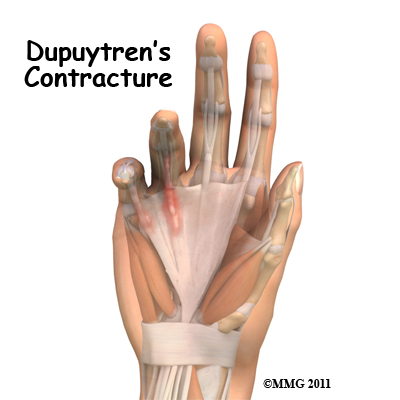
Dupuytren's contracture is a fairly common disorder of the fingers. It most often affects the ring or little finger, sometimes both, and often in both hands. Although the exact cause is unknown, it occurs most often in middle-aged, white men and is genetic in nature, meaning it runs in families. This condition is seven times more common in men than women. It is more common in men of Scandinavian, Irish, or Eastern European ancestry. Interestingly, the spread of the disease seems to follow the same pattern as the spread of Viking culture in ancient times. The disorder may occur suddenly but more commonly progresses slowly over a period of years. The disease usually doesn't cause symptoms until after the age of 40.
Both non-surgical and surgical treatment options are available for Duputryen’s contracture, but this guide will focus on the surgical option. For more information on the non-surgical options, refer to A Patient's Guide to Dupuytren's Contracture.
In regards to surgical procedures a partial palmar fasciectomy remains the “gold standard” procedure, although at earlier stages of this disease a less invasive surgical procedure called a needle aponeurectomy may be done.
It should be noted that surgical treatment does not always stop or cure this disease process, so recurrence can occur.
This guide will help you understand:
-
what your surgeon hopes to achieve
-
what happens during the operation
-
what to expect after the procedure
-
Northern Hills Sport Physiotherapy’s approach to rehabilitation after surgery
Anatomy
What part of the hand is affected?
The palmar fascia lies under the skin on the palm of the hands and fingers. This fascia is a thin sheet of connective tissue shaped somewhat like a triangle. It covers the tendons of the palm of the hand and holds them in place. It also prevents the fingers from bending too far backward when pressure is placed against the front of the fingers. The fascia separates into thin bands of tissue at the fingers. These bands continue into the fingers where they wrap around the joints and bones. Dupuytren's contracture forms when the palmar fascia begins to thicken and tighten, causing the fingers to bend.
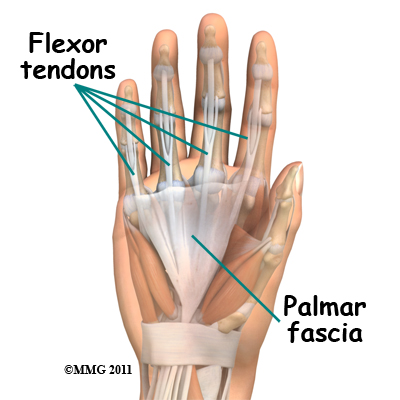
This condition commonly first shows up as a thick nodule (knob), or a short cord in the palm of the hand, just below the ring finger. More nodules form and the tissues thicken and shorten until the finger cannot be fully straightened.
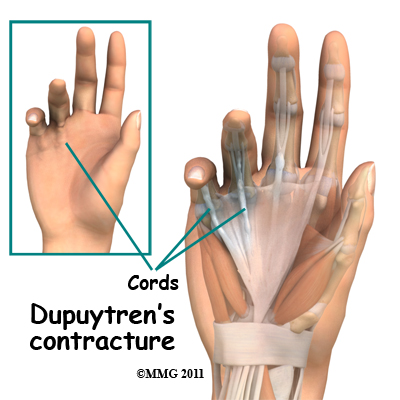
Related Document: Northern Hills Sport Physiotherapy's Guide to Hand Anatomy
Hand Anatomy Introduction
Rationale
What is the goal of surgery?
Many cases of Dupuytren's contracture progress to the point where surgery is needed. The goal of surgery is to remove the diseased fascia, allowing the finger to straighten out again. By removing the tight cords and fascia, the tension on the finger is released. Once the fibrous tissue is removed, the skin is sewn back together with fine stitches.
In some cases, grafting extra skin is necessary in the area close to the incision to give the finger more flexibility to straighten. Skin grafting is more commonly necessary in severe Dupuytren's contractures that have been present for many years. Over this lengthy time the skin itself also contracts. When the contracture or the cord is released, the skin cannot stretch enough to allow the finger to straighten. Skin is added, or grafted into place to allow the finger to straighten without being held back by the tight skin of the palm.
Preparation
How should I prepare for surgery?
The decision to proceed with surgery must be made jointly by you and your surgeon. Your physiotherapist may also provide input regarding failed conservative (non-surgical) treatment, which may lead you to the option of surgical treatment. You need to understand as much about the procedure as possible. If you have concerns or questions, you should talk to your surgeon.
Once you decide on surgery, you need to take several steps. Your surgeon may suggest a complete physical examination by your regular doctor. This exam helps ensure that you are in the best possible condition to undergo the operation.
Surgery for Dupuytren's Disease is commonly performed as an outpatient, meaning that you will probably go home the same day. The surgical procedure may be performed in an operating room in a surgery center or hospital. The needle aponeurotomy may be performed in the office setting. On the day of your surgery, you will arrive at the location chosen by the surgeon and the staff will register and prepare you for the procedure. You shouldn't eat or drink anything after midnight the night before.
Surgery
What happens during the operation?
The needle aponeurotomy is available when the disease is at an early stage. Under local anesthesia, the surgeon inserts a very thin needle under the skin. The sharp needle cuts a path through the cord, weakening it enough so that when the surgeon straightens the finger the cord will snap or rupture and this allows the finger to straighten. The diseased tissue is not removed. This type of procedure can be done in an office setting.
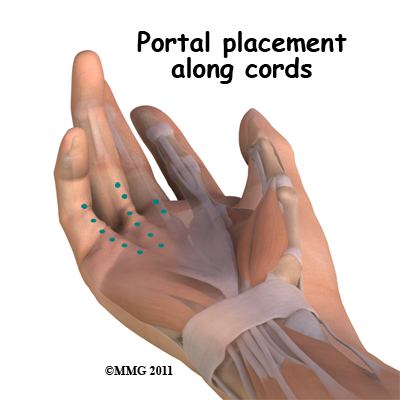
Needle aponeurotomy may be used when a patient has a contracture that's due to a palpable cord lying beneath the skin. It does not work for non-Dupuytren's related contractures. The advantage of this procedure is that it can be done on older adults who have other health issues that might make surgery under general anesthesia too risky. The disadvantage is there can be a high recurrence rate because the diseased tissue remains and can continue to contract. There is also the potential for nerve injury, infection, and hematoma (pocket of blood) formation. These complications are similarto the open procedure.
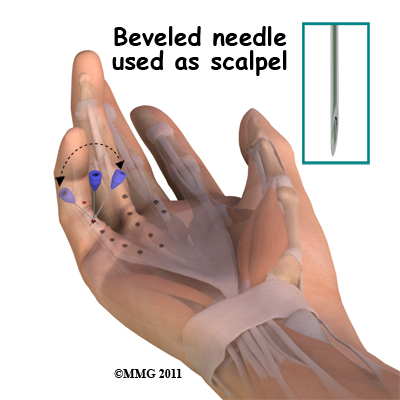
Surgery can last up to 90 minutes. Surgery may be done using a general anesthetic (one that puts you to sleep during surgery), or a local anesthetic (one that only numbs the hand). With a local anesthetic you may be awake during the surgery, but you won't be able to see the surgery.
Once you have anesthesia, your surgeon will make sure the skin of your palm is free of infection by cleaning the skin with a germ-killing solution. An incision will be made in the skin. Several types of incisions can be made, but yours will most likely be made along the natural creases and lines in the hand. This will help make the scar less noticeable once the hand is healed.
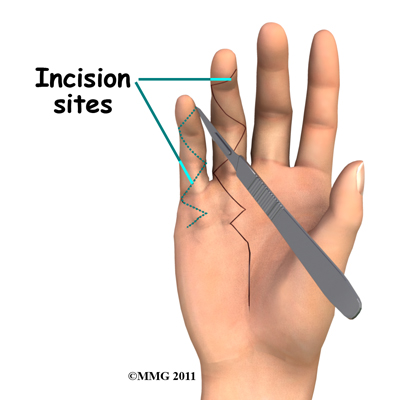
Once the palmar fascia is exposed, it will be carefully separated from nerves, arteries, and tendons. Special care is taken not to damage the nearby nerves and blood vessels.
Next your surgeon will remove enough of the diseased palmar fascia to allow you to straighten your finger(s). If the problem has been ignored for a long time, the joint capsule or the ligaments of the joint may also be stiff or contracted. The surgeon may therefore also need to release these tissues in order to allow the finger to straighten normally. Once the fibrous tissue is removed, the skin is sewn back together with fine stitches.
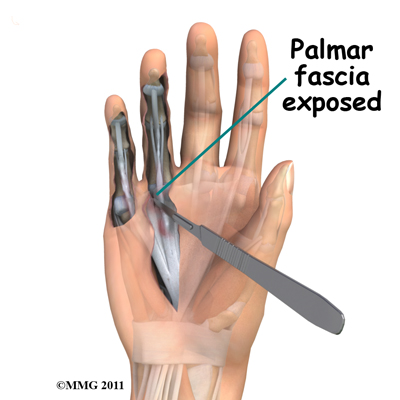
A skin graft may be needed if the skin surface has contracted so much that the finger cannot relax as it should and the palm cannot be stretched out flat. Surgeons graft skin from the wrist, elbow, or groin.
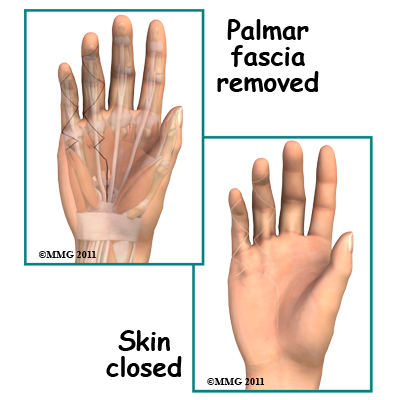
Complications
What might go wrong?
As with all major surgical procedures, complications can occur. This document doesn't provide a complete list of the possible complications, but it does highlight some of the most common problems. Some of the most common complications following surgery for Dupuytren's contracture are:
- anesthesia related issues
- infection
- nerve and blood vessel damage
Problems can arise when the anesthesia given during surgery causes a reaction with other drugs the patient is taking. In rare cases, a patient may have problems with the anesthesia itself. In addition, anesthesia can affect lung function because the lungs don’t expand as well while a person is under anesthesia. Be sure to discuss the risks and your concerns with your anesthesiologist.
Infection of the incision is one possible complication after surgery. Therefore, check your incision every day as instructed by your surgeon. If you think you have a fever, take your temperature, as this is a sign of infection. If you have a fever or other signs of infection or other complications, call your surgeon right away.
There are many nerves and blood vessels in the hand. It is possible, though uncommon, that these structures can be injured during surgery. If an injury occurs, it can be a serious complication. Injury to nerves can cause numbness or weakness of the hand. Repairing an injury to the blood vessels may require additional surgery.
After Surgery
What happens after surgery?
After a needle aponeurotomy, small adhesive bandages may be applied, or a light gauze wrap. Elevation and ice are recommended for several days following the procedure. Rehabilitation will begin once these bandages are removed.
After a partial palmar fasciectomy, your hand will be bandaged with a well-padded dressing and a splint for support. The splint will keep the hand open and the fingers straight during healing. Your surgeon will want to check your hand within five to seven days. Stitches will be removed after 10 to 14 days, though most of your stitches will be absorbed into your body. Due to the many nerves found in the hand, you may have some discomfort after surgery. You will be given pain medicine to control the discomfort.
You should keep your hand elevated above the level of your heart for several days to avoid swelling and throbbing. Keep it propped up on a stack of pillows when sleeping or sitting up.
Rehabilitation will generally begin after your stitches are removed, or as soon as your surgeon feels it is appropriate.
Rehabilitation
What should I expect during my recovery?
Extensive physiotherapy is not required after a needle aponeurotomy, however a few sessions at Northern Hills Sport Physiotherapy will start your recovery on the right track. Your physiotherapist will do some gentle stretching with you and provide you will home exercise regime that you will do independently. You should not be doing any strenuous gripping for one week after your aponeurotomy. After this time you will be able to return to activities as tolerated. Occasionally a splint is prescribed for night use.
Rehabilitation after a palmar fasciectomy is considerably more extensive. Although the time required for recovery varies, as a guideline, you may expect to attend physiotherapy sessions for up to six weeks. Our physiotherapist may apply heat treatments, soft tissue massage, and a program of vigorous stretching. Our physiotherapist at Northern Hills Sport Physiotherapy will provide you with a personalized program to speed your recovery.
Attending the recommended physiotherapy sessions can make the difference to a successful result after fasciectomy surgery. These sessions are important in limiting the buildup of scar tissue, preventing the return of contractures, and getting the most benefit from surgery.
Our physiotherapist may recommend that your wear a splint at night for up to six months after surgery. It is used to keep the joints straight, and prevent new contractures from forming. You will gradually be able to put your hand to use, and should be able to straighten all joints within about four to eight weeks or sometimes slightly longer.
At Northern Hills Sport Physiotherapy, our goal for physiotherapy is to help speed your recovery so that you can more quickly return to your everyday activities. When your recovery is well under way, regular visits to our office will end. Although we will continue to be a resource, you will be in charge of independently doing your exercises as part of an ongoing home program.
Generally physiotherapy at Northern Hills Sport Physiotherapy occurs without any issues, and full recovery occurs provided our advice is closely followed. If, however, your recovery is not progressing as your physiotherapist feels it should, we will ask you to return to your surgeon for a follow-up visit to ensure there are no complications, which are impeding your recovery.
Portions of this document copyright MMG, LLC.
Northern Hills Sport Physiotherapy provides services for physiotherapy in Calgary.











